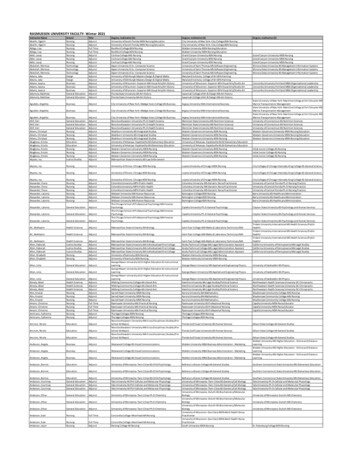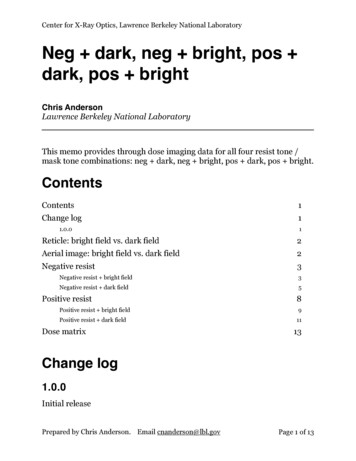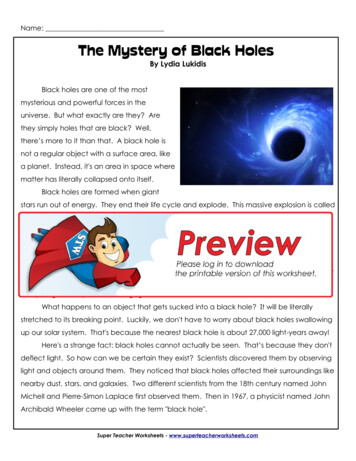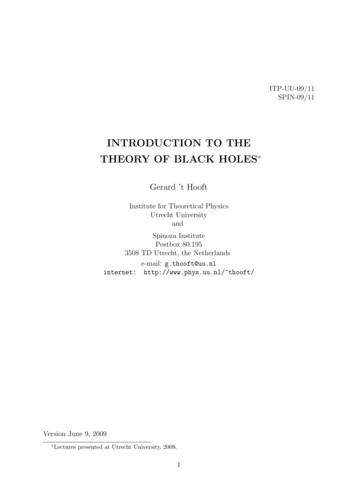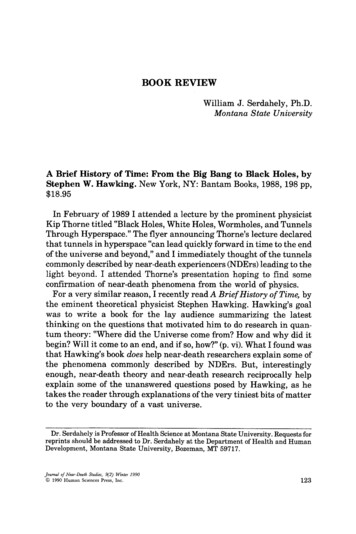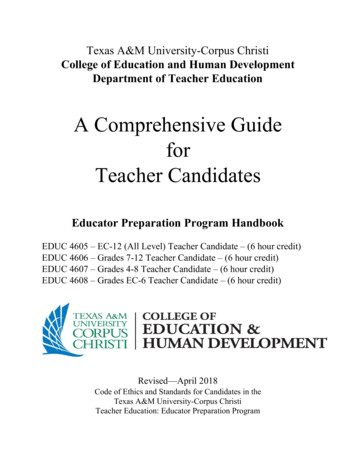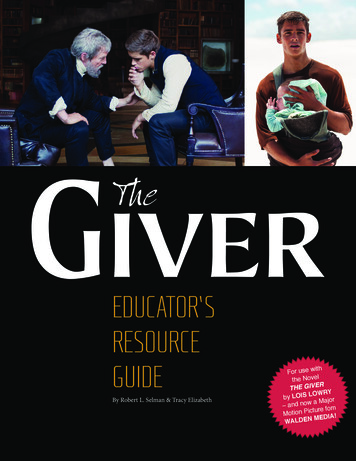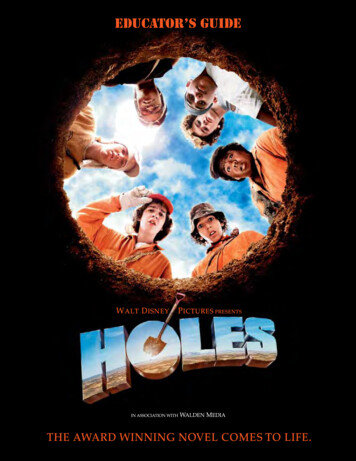
Transcription
EDUCAToR’S GUIDE
Dear Educator,As the author/screenwriter and director of Holes, we are proud of itstranslation from page to screen. We believe that the film carries a powerfulhuman message.The boys living at Camp Green Lake have all lived hard-luck lives. Eachcarries the scars of a world that all too often forces kids to confront theharsh realities of homelessness, poverty, abuse, absent authority figures,and illiteracy. Though these are difficult topics, the ultimate message ofthe film is one of redemption and hope.We think you and your students will feel great sympathy for the kids atCamp Green Lake, especially Stanley “Caveman” Yelnats and Hector “Zero”Zeroni. You will like the quirky characters, intricate plot, the adventurestory, and most of all, the message that friendship and learning reallymatter. Stanley and Zero are both kids having a tough time making it inthe world around them. Through perseverance, loyalty, and courage, theyrise to become accepted as heroes by the boys who previously rejectedthem. Stanley is able to end a family curse because he takes the time toteach and stand by a friend. Zero solves a hundred-year mystery throughhis newfound ability to read.Our preview audiences have told us that Holes is a great film with a greatmessage. We hope that this Educator’s Guide, the educational poster, andthe web site help you as an educator to reinforce the lessons learned inboth the novel and the film. We know that these materials can serve asintegral parts of a thoughtful and rewarding learning experience. If ourfilm can serve to make your kids more excited about reading, inspire themto go out and mentor other kids to read, or simply engage them to digdeeper into other subject matter, then we have all succeeded.We are excited to bring both the film and these educational materials toyou. We hope you enjoy them.Best wishes,Louis Sachar, Author/ScreenwriterAndy Davis, Director
CONTENTSUsing tHis GUIDEThis guide is designed for teachersto help integrate the film Holes intothe classroom. All lessons are targeted to students in grades 5–8 andcomply with national content standards. Each lesson also includes an“adaptation” with suggestions forhow to scale the lesson for use withyounger students. The reproducibleworksheets and lesson plans coversubject areas including languagearts, science, history, and technology.Our Making Connections page showsyou how lessons can fit together andbe taught as a comprehensive series.For an overview of content standardscorrelations in this guide, please seethe chart on the National EducationalStandards page.ACKNOWLEDGEMENTSWRITERJanet Walters, Ed.M.CONTRIBUTING EDITORSJean Kwon, Ed.M.Karin LeMaire CrounseREVIEWERSBarbara Dorff, M.Ed.Social Studies Specialist and Texas SecondaryTeacher of the Year, 2002Dallas Independent School DistrictDallas, TX2About The Movie3Making CoNNections4Lesson 1. Zero The Hero, Trout The Lout – Character Study6Lesson 2. Conflicted – Examining Conflicts At Camp Green Lake7Lesson 3. Flashbacks – Illuminating The Past To BrightenThe Present8Lesson 4. Chain Reactions – Cause And Effect10Lesson 5. Like It Or Not? Write A Review Of Holes, The Movie11Lesson 6. Two Lives Collide – Stanley And Zero14Lesson 7. The Desert Biome15Lesson 8. Park Ranger In Training16Lesson 9. Leapin’ Lizards And Other Facts About ReptilesAnd Amphibians18Lesson 10. Jim Crow Laws And The American South20Lesson 11. Westward Expansion – Chief Joseph’s WordsOf Surrender22Lesson 12. The Primary Source24National Educational Standards Chart25Useful ReferencesSusie Sung, M.Ed.3rd Grade TeacherFiske Elementary SchoolLexington, MACOPY EDITORSAlissa Farber, Citizens School FellowDavid Kramer, Citizens School FellowBarbara Byrne, Ed.M., Former 7th Grade Teacher, NJJohn Evan Roberts, Ed.M.7th Grade Science and 9th Grade English TeacherFowlerville Junior High SchoolFowlerville, MISpecial thanks to: Jack Pan, Micheal Flaherty, DeborahKovacs, and Erin MackeyJulie Cohen, MLSDirector of Libraries, K-12Berkshire Country Day SchoolStockbridge, MA1This guide may be reproduced for educational purposesonly. Cover art reprinted courtesy of Buena Vista PicturesDistribution. 2003 Buena Vista Pictures Distributionand Walden Media, LLC. All rights reserved. Stills,text, and design 2003 Walden Media, LLC. WaldenMedia and the Walden Media skipping stone logo aretrademarks of Walden Media, LLC. All rights reserved.
ABOUTTHE MOVIE Based on the award-winning book by Louis Sachar, Holes is a funny and poignant coming-of-age adventure.It tells the story of Stanley Yelnats (Shia LaBeouf) – an unusual young hero, dogged by bad luck stemmingfrom an ancient family curse. Perpetually in the wrong place at the wrong time, Stanley is unfairly sentencedto months of detention at Camp Green Lake for a crime he didn’t commit. There, he and his campmates –Squid, Armpit, ZigZag, Magnet, X-Ray, and Zero – are forced by the menacing Warden (Sigourney Weaver)and her right-hand men Mr. Sir (Jon Voight) and Mr. Pendanski (Tim Blake Nelson) to dig holes in order tobuild character. Nobody knows the real reason they’re digging all these holes, but Stanley soon begins toquestion why the Warden is so interested in anything “special” the boys find. Stanley and his campmatesmust stick together and keep one step ahead of the Warden and her henchmen as they plot a daringescape from the camp to solve the mystery and break the Yelnats family curse.About Louis SacharLouis Sachar was born in EastMeadow, New York. He still remembers how cool it was to visit his fatherin his office on the 78th floor of theEmpire State Building. When hewas nine, Louis moved to southernCalifornia. Today he calls Austin,Texas home.Bathroom. They were married in1985 and their daughter Sherre wasborn in 1987. She was four years oldwhen he started writing the MarvinRedpost series – hence Marvin hasa four-year-old sister. In his freetime, Louis likes to play bridge, hikewith his dogs, and spend time withCarla and Sherre.Louis met his wife, Carla, when hevisited her elementary school tospeak about his first book, SidewaysStories from Wayside School. Shebecame the inspiration for the counselor in There’s a Boy in the Girl’sAmong Louis Sachar’s numerouswriting awards are: the NewberyMedal, the National Book Award, theSchool Library Journal Best Book ofthe Year (all for Holes), and more 2003 Walden Media, LLC2than 30 individual state awardsfor the best book of the year, allvoted upon by the children in therespective states.Louis says he had a wonderful firstexperience in Hollywood – muchbetter than he ever could haveimagined. Not only was he tappedto write the screenplay for Holes,he was on the set every day, sittingnext to the director, Andy Davis.Be sure to watch for Louis’ cameoappearance during the film!www.holes.com
MAKING CONNECTIONSYou can teach the lessons in this guide as stand-alone activities or use the lessons in each subject as acomprehensive series. See how it all connects!Language ArtsSocial SciencesLesson 1: Zero The Hero, Trout The Lout –Character StudyLesson 6: Two Lives Collide – StanleyAnd ZeroLesson 10: Jim Crow Laws And TheAmerican SouthSince this is an activity that can berepeated every time students areintroduced to a new character,have students keep these charactersketches in a folder. These pagesare helpful for the essay assignmentin Lesson 6.The ideas and quotations collected inLanguage Arts Lesson 1 are helpfulfor this essay if students completedcharacter sketches for both Stanleyand Zero. The students can use thatinformation as evidence and examples for their essays.Lesson 2: Conflicted – Examining ConflictsAt Camp Green LakeScienceBeyond the relationship betweenMiss Katherine and Sam, the OnionMan, the boys of Camp Green Lakeare aware of racial differences andthe strain it can put on relationships. These examples might be away to make the idea of the CivilRights movement more accessibleto students.Conflict is often a result of characterswe call antagonists. Based on thecharacter sketches students havemade, which characters might beantagonists? Protagonists?The process of desertification, thechange of arable land into a desertfrom natural or human causes, isthe process that creates the settingof present day Camp Green Lake.This lesson is the first of three ondeserts, desert wildlife, and issuessurrounding water use.Lesson 3: Flashbacks – Illuminating ThePast To Brighten The Present!The flashbacks in Holes can be difficult for some students. Thinkingabout this idea now may make thediscussion of cause and effect inLesson 4 more effective.Lesson 4: Chain Reactions – CauseAnd EffectReviewing the work done in the lessonon flashbacks may help facilitate thediscussion on cause and effectbecause the chronological order ofevents begins to be important forunraveling the puzzle that is Holes.Lesson 5: Like It Or Not? Write A ReviewOf Holes, The MovieMovies inevitably change parts of abook when they are put into a script.Push students’ thinking beyondwhether they simply like or dislikethe movie to support that opinionwith specific changes or omissionsthat might alter the story.Lesson 7: The Desert BiomeLesson 8: Park Ranger In TrainingWater, weather, and chemicals contribute to erosion and result inmany rock formations. In this lesson,students will pretend to be parkrangers explaining the naturalhistory of specific rock formations.Lesson 9: Leapin’ Lizards And OtherFacts About Reptiles And AmphibiansThe arid conditions of the desertbiome require living things to adaptin order to survive. Ask studentsto propose these adaptations beforeresearching them. Even Stanley noticeshis own body adapting to the conditions of Camp Green Lake.Lesson 11: Westward Expansion – ChiefJoseph’s Words Of SurrenderChief Joseph’s speech, read aloudin this lesson, is a primary source.Primary sources are the subject ofLesson 12.Lesson 12: The Primary SourceStudents will have prior knowledgeof a primary source. One suchexample is Chief Joseph’s speechin Lesson 11.TIPS FOR THEONE-COMPUTERCLASSROOMThe following are a few suggestions forteachers with one or very few computersavailable to students: Hook up the computer to a video monitoror a projector so that the class can browsethe web together. Invite students to participate by taking turns clicking on thehyperlinks or reading information aloud. Assign small groups of students to worktogether on the computer for about 15 to20 minutes in rotation. Give the rest ofthe class other related activities to dowhile waiting their turn on the computer. If students have access to the Internet athome, consider assigning certain activitiesas homework. You can get them startedwith the project in class and have themfinish their work at home. 2003 Walden Media, LLC3www.holes.com
Teacher PageZERO THE HERO, TROUT THE LOUTCHARACTER STUDYGRADE LEVEL: 5–8SUBJECT: Language ArtsDURATION: One 40-minute class periodNATIONAL STANDARDS: Language Arts, Standard 3: Evaluation strategiesMATERIALS: Student worksheet, writing journalsUse this lesson to map out character traits for a character from Holes.DESCRIPTIONA character sketch is a short piece of writing that reveals or shows something important about a person or fictionalcharacter. Think about the different characters in Holes. Some are likeable, and some are not so likeable. Studentswill choose one main character from Holes to diagram in the worksheet.OBJECTIVESPROCEDURES To demonstrate an understanding of character traits To recall facts, characters, and events from Holes, andevidence for certain character traits1. Instruct students to think about the character ofTrout Walker. Then work toward the idea of charactertraits. Start with a problem or idea and then discoverthe solution or answers along the way. Where in thestory do these character traits reveal themselves?ADAPTATIONSFor younger students, follow the same procedures. Inplace of the worksheet, have students draw a pictureof a character of their choice from the story. Instructstudents to draw the character in the scene that bestportrays the character’s traits.2. Copy the worksheet chart on the blackboard.3. Fill in the chart with the students. Use Trout Walkeras an example.4. Write Trout Walker’s name in the center of the chart.ASSESSMENT5. Instruct students to think of four characteristic traitsof Trout Walker (see answer key). To initiate discussion: Describe Trout Walker’s personality. What aresome distinguishing features or traits that describehis character? What does Trout say or do in the bookor movie that proves your ideas? Write the four traitsin the oval shapes.Design a five-point rubric to assess students on theirdemonstrated understanding of character traits asindicated by their word choice and scene selectionsfrom Holes.EXTENsIONS Use the worksheet as a springboard for a creativewriting exercise. Have students imagine a characterthey want to write a story about. Using the worksheet,students can flesh out their character’s personalitytraits and brainstorm scenes or events that they wantto incorporate into their stories. Use the filled-out worksheets as an opportunity todiscuss literary terms such as dynamic, static, round,and flat which describe the characters. Place characters into their respective category.6. For each trait, ask students to return to the Holesbook or movie and find two instances when thecharacter displayed each trait. Whenever possible,have students find specific quotations and use themas examples of “evidence” to write in the rectangles.ANSWER KEY: Trout walkerCharacteristic/trait: Rich1. His family owned most of the peach trees and land east ofGreen Lake.2. Bought a new motorboat.Characteristic/trait: Influential1. Gets the townspeople to help him burn down the schoolhouse.2. Knowing that Trout’s behind the schoolhouse burning, thesheriff doesn’t do anything about it.USEFUL RESOURCESSparkNotes’ concise descriptions of the main Holes .htmlCharacteristic/trait: Conceited1. “No one ever says, ‘No’ to Charles Walker.”2. Can’t believe that Katherine doesn’t like him.Teacher Vision’s list of character 669.htmlCharacteristic/trait: Hateful1. Trout kills Sam.2. Trout calls Katherine “The Devil Woman.”The Writer’s Guide to Character Traits, by Linda N.Edelstein, Writer’s Digest Books, 1999. 2003 Walden Media, LLC4www.holes.com
STUDENT PageZERO THE HERO, TROUT THE LOUTCHARACTER STUDYNameDatewhat is A character Sketch?A character sketch is a short piece of writing that reveals or shows something important about aperson or fictional character. Think about the different characters in Holes. Some are likeable, andsome are not so likeable. Choose one main character from Holes to diagram in the chart below.InstructionsWrite the name of the character you choose in the center. (Draw a picture of the character if you like.)Then think of four character traits of this character (for example: loyal, brave, hostile). Write the fourtraits in the oval shapes. For each trait, find two instances in the book or movie when the characterdisplayed each trait. Whenever possible, look for exact quotations by the character to use as proof.Write these examples in the fCharacterProof 2003 Walden Media, LLCracteristic/traitCha5Proofwww.holes.com
teacher pageCONFLICTEDEXAMINING CONFLICTS AT CAMP GREEN LAKEGRADE LEVEL: 5–8SUBJECT: Language ArtsDURATION: One 40-minute class periodNATIONAL STANDARDS: Language Arts, Standard 4: Communication skills, Standard 6: Applying knowledgeMATERIALS: Writing journalsUse this lesson to understand conflict as a literary device that triggers action in a story.DESCRIPTIONASSESSMENTConflict is a problem or struggle in a story that triggersaction. There are six basic types of conflict:Design a five-point rubric to assess students on theirdemonstrated understanding of literary conflict basedon evidence in their essay or paragraph.Person vs. Person: One character has a problem withone or more of the other characters.EXTENSIONSPerson vs. Society: A character has a problem withsome element of society: the school, the law, theaccepted way of doing things, etc. Using a dictionary or language arts textbook, instructstudents to define several of the literary terms belowand identify examples of each from Holes.Literary terms:ActionAntagonistClimaxDenouementFalling actionFlashbackForeshadowingLocal colorPlotProtagonistRising actionThemePerson vs. Self: A character has a problem decidingwhat to do in a particular situation.Person vs. Nature: A character has a problem withsome natural occurrence: a snowstorm, an avalanche,the bitter cold, or any other element of nature.Person vs. Fate: A character has to battle what seemsto be an uncontrollable problem. Whenever the problemseems to be a strange or unbelievable coincidence, fatecan be considered the cause of the conflict. Lead a discussion with students about the connectionsbetween literary conflict and conflict in the “real world.”PROCEDURESPerson vs. Machine: A character has to confronttechnology or other elements of human creation(as opposed to natural or divine creation).1. Introduce a conflict from Holes for students to consider.2. Review the six basic types of literary conflicts in class.3. Ask students to identify one type of conflict they thinkis represented in Holes.4. Instruct students to write a five-paragraph essayabout the type of conflict they have identified. Reviewwith students the elements of the five-paragraphessay (an opening paragraph with a thesis statement,three body paragraphs with specific facts to supportthe thesis statement, and a closing paragraph).OBJECTIVES To understand literary conflict To identify a key literary conflict in Holes To write a clear and logical five-paragraph essaydescribing one type of conflict represented in theHoles movie or bookADAPTATIONS Younger students should write a single, logical, andclear paragraph describing one type of conflictrepresented in Holes. Write and define the six different types of conflict onseparate chart paper. Add book titles under each typeand continue to add to these lists throughout the year.USEFUL RESOURCESA Dictionary of Literary Devices: Gradus, A-Z, by Bernard Dupriez, Albert W. Halsall (Translator), University of TorontoPress, 1991.Literary Visions: Patterns of Action: Plot and Conflict in Drama, distributed by Annenberg/CPB Channel:www.mkn.org/Handbook/splash assets/html/L/LiteraryVisions/literary visions20.html 2003 Walden Media, LLC6www.holes.com
teacher pageFLASHBACKSILLUMINATING THE PAST TO BRIGHTEN THE PRESENT!GRADE LEVEL: 5–8SUBJECT: Language ArtsDURATION: One 40-minute class period, one homework assignmentNATIONAL STANDARD: Language Arts, Standard 6: Applying knowledgeMATERIALS: Writing journalsUse this lesson to have students define flashback and identify several examples in Holes.DESCRIPTIONA flashback is a literary device used to show the audience something that occurred before the story. It is used tohelp us better understand what is happening now or to make us think differently about why certain events anddecisions are occurring.OBJECTIVESPROCEDURES To define flashback To demonstrate an understanding of flashback as aliterary device by identifying scenes in Holes whereflashback is used To use understanding of flashback in a short, originalcreative writing piece1. Write the definition of flashback on the board or overhead projector. Ask students to copy the definition intheir journals.2. Review with students some examples of flashbacksfrom Holes.3. Instruct students to respond to the following writingprompt:Describe flashback and explain how it is used intelling the story, Holes.ADAPTATIONSNone neededASSESSMENTS4. For homework, have students write a two to threepage creative short story with one flashback scene.Design a five-point rubric to assess students on theirdemonstrated understanding of the term flashback asindicated by their choice of scene or event from Holes.Assess understanding through the use of a flashbackscene in their creative piece. How well does the flashback scene help us understand the story? Is the storymade clearer or more intriguing as a result of thescene’s addition?EXTENSIONSDefine foreshadowing as a literary term. Ask studentsto point to places in Holes where foreshadowing as aliterary device is put to use.USEFUL RESOURCES3 Tips for Writing Successful Flashbacks, by Nancy Kress: acks.aspWriteguide.com’s Letter Writing Program – Lesson Four: PDFA Dictionary of Literary Devices: Gradus, A-Z, by Bernard Dupriez, Albert W. Halsall (Translator),University of Toronto Press, 1991. 2003 Walden Media, LLC7www.holes.com
TEACHER PAGECHAIN REACTIONSCAUSE AND EFFECTGRADE LEVEL: 5–8SUBJECT: Language ArtsDURATION: One 40-minute class periodNATIONAL STANDARD: Language Arts, Standard 3: Evaluation strategiesMATERIALS: Synopsis or list of the main events in Holes, ordered by occurrence in the story, student worksheetUse this activity to help students learn to distinguish and/or choose important information from a text, and also begin to understanda narrative as a causal chain of events.DESCRIPTIONHoles is a complicated story, spanning not only generations of Yelnatses but also numerous events and seeminglyendless days of digging holes. The tangled plot, including countless flashbacks, presents a great opportunity todevelop the ability to decode a written text or various story lines.OBJECTIVESPROCEDURES To reconstruct temporal order in a narrative To identify cause and effect relationships in thedevelopment of a narrative1. Ask students to choose four or five major eventsfrom the story.2. Direct students to select four final choices to use inthe chain.ADAPTATIONSFor younger students, go to the Holes movie web site,www.holes.com, to download movie images of major eventsfrom the story. Students will cut out the pictures andpaste them on a separate sheet of paper in chronologicalorder. Discuss cause and effect.3. Students will write each event in the appropriatespace of the chain, giving careful attention to thechronological order of events.4. Last, students will write the cause and effect of eachevent in the related links of the chain.ASSESSMENTDesign a five-point rubric to assess student successin correctly reordering events chronologically, and toassess the ability to identify and understand the causeand effect for each event.EXTENSIONSGuide a discussion to encourage students to thinkcritically about cause and effect: Ask students to consider the process that a writer goesthrough in designing a story by asking the followingquestion: would the Holes story have been better if ithad been presented in straight chronological order? Explore the differences between cause and effect ina narrative and cause and effect in historical events.Which is more complex? Why? How can we understandhistory if no simple cause and effect chain exists?USEFUL RESOURCESCause-and-Effect Writing Challenges Students, by Mary Daniels Brown, Education World , 2001:www.educationworld.com/a curr/curr376.shtmlMethods of Development – Cause and Effect: .htmReady to Write More: From Paragraph to Essay, by Karen Blanchard and Christine Root, Addison-Wesley PublishingCompany, 1997. 2003 Walden Media, LLC8www.holes.com
STUDENT PAGECHAIN REACTIONSCAUSE AND EFFECTNameDateHoles is a complicated story, spanning not only generations of Yelnatses but also numerous eventsand seemingly endless days of digging holes. Fill in the cause and effect chain below to recallimportant events from the story.First, list four or five major events from the story, then pick four to write in the appropriate spacesof the chain. Then, identify each event’s cause and effect, and put these in the appropriate spaces ofthe chain. Remember to give careful attention to the chronological order of events.Possible Events to Use in the ChainTop Four Event Choices1.2.3.4.of event 1causet of event 1Effecof event 2CauseEffecof event 4causet of event 3effect of event 2of event 3causet of event 4effec 2003 Walden Media, LLC9www.holes.com
teacher pageLIKE IT OR NOT?WRITE A REVIEW OF HOLES, THE MOVIEGRADE LEVEL: 5–8SUBJECT: Language ArtsDURATION: Two 40-minute class periods, one homework assignmentNATIONAL STANDARDS: Language Arts, Standard 4: Communication skills, Standard 5: Communication strategies,Standard 6: Applying knowledgeMATERIALS: Sample movie reviews from various print media, background information about Holes at www.holes.comUse this lesson to have students write a review of Holes, the movie.DESCRIPTIONThe aim of a movie review is to help readers decide if they should go see a particular film. Movie reviews are shortessays expressing the reviewer’s personal opinion about a particular movie. An effective movie review is informativeand enjoyable to read, and highlights important parts of the movie without giving the whole story away.OBJECTIVESPROCEDURES To understand the components of a story and how itis retold through film To clearly express personal opinion in writing To support personal opinion with facts and details1. Prior to the lesson, ask students to bring in moviereviews from various sources.2. Discuss the purpose of a movie review and elementsof an informative and well-written review. Remindstudents that a review is a type of persuasive writingthat includes an opinion supported by facts and details.ADAPTATIONSFor younger students, focus the lesson on answeringthree important questions for a book or movie review:1. What is the movie about?2. What is the movie’s theme?3. Did I like it or not, and why?3. Define and review literary terms that are potentiallyuseful such as plot, characters, setting, and theme.ASSESSMENT4. Discuss the elements that students may want toexamine, such as credible characters and specialeffects.Design a five-point rubric to assess students on theirability to clearly express a written opinion of the movie.Focus on the degree to which the students back up theiropinion with specific examples.5. Instruct students to write a three to five-paragraphreview of Holes. It might be beneficial to designateextra classroom time, or assign this writing pieceas homework.EXTENSIONS Allow access to a video camera for students to filmtheir review in a mock-televised format. Ask a local reporter who has reviewed Holes to visitthe class. Prepare students for the visit by having themwrite questions for the guest. Guide a class discussioncomparing the review written by the reporter to theones written by the students. Publish a few of the reviews in the school newspaper.USEFUL RESOURCESSample movie reviews can be found at the following web rt.htmlwww.rottentomatoes.comPBS Kids offers student-written movie reviews: www.pbskids.org/zoom/reviews 2003 Walden Media, LLC10www.holes.com
teacher pageTWO LIVES COLLIDESTANLEY AND ZEROGRADE LEVEL: 5–8SUBJECT: Language ArtsDURATION: One 40-minute class periodNATIONAL STANDARDS: Language Arts, Standard 3: Evaluation strategies, Standard 4: Communication skillsMATERIALS: Chalkboard/overhead projector, writing journalsUse this lesson to have students write an essay comparing and contrasting the characters of Stanley and Zero using a Venn diagram as a guide.DESCRIPTIONIn Holes, Stanley and Zero are two heroic figures drawn together by shared motivations – to escape alive from thetorture and misery of Camp Green Lake. Each character has unique qualities, yet they are also alike in many ways.OBJECTIVESPROCEDURES To use a Venn diagram to compare the two maincharacters, Stanley and Zero To write a compare and contrast essay1. Discuss with students the ideas of comparing andcontrasting one thing to another. Music groups,clothing, and even classes are things that are oftencompared. Discuss the meaning of “unique” and“shared” qualities.ADAPTATIONSFor younger students, complete the Venn diagram as aclass. Instruct students to write a single, well-writtenparagraph about one of the three categories, A, B, or C.2. Draw a sample Venn diagram on the board oroverhead projector as follows:ASSESSMENTADesign a five-point rubric to assess students on qualityof class contribution, completion of their own Venndiagram, and demonstrated use and understanding ofthe Venn diagram as a prewriting tool. The final essayshould be used as the final assessment tool.(Stanley)CB(Zero)3. Ask students to draw the same diagram.EXTENSIONS4. Ask students to list unique qualities to describeStanley. Write these qualities in the Venn diagram insection A. Give students the opportunity to look backat their character study from Lesson 1 to help provideevidence.Define the qualities of a heroic character. What makesStanley a literary hero? What makes Zero a literaryhero? Write a paragraph explaining why. Use the website www.forbetterlife.org to find a good list of heroicqualities.5. Next, ask students to list unique qualities for Zero.Have students write these details down in section B.Write them in the Venn diagram on the board oroverhead projector.6. In section C, have students write characteristicsshared by the two characters.7. Review students’ answers aloud in class. Encouragestudents to add to their lists.8. Instruct students to write a compare and contrastessay from their diagram. The first paragraph shoulddiscuss characteristics about Stanley, drawn from thefirst section. The second paragraph should describeZero. In the third paragraph, write about the characteristics shared by both characters.USEFUL RESOURCESInformation on using a Venn diagram: www.sdcoe.k12.ca.us/score/actbank/tvenn.htm 2003 Walden Media, LLC11www.holes.com
Author/screenwriter, Louis Sachar
Using tHis GUIDE This guide is designed for teachers to help integrate the film Holes into the classroom. All lessons are tar-geted to students in grades 5–8 and comply with national content stan-dards. Each lesson also includes an “adaptation” with suggestions for how to scale t

